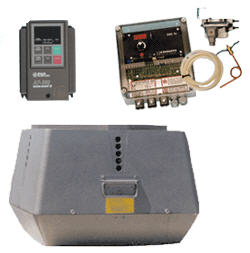Exhaust Draft Control
 Introduction
Introduction
Boilers must maintain a proper flue draft for efficient combustion; too little draft can result in condensation, CO formation, flue gas spillage, and soot formation. Too much draft results in lost thermal energy from the boiler and higher electrical usage by the vent fan.
Gravity / barometric pressure systems must be over-sized in order to function in the worst conditions. This leads to wasted energy and higher installation costs. Fixed speed power vent systems also waste energy by not being able to adjust to actual conditions.
A new system with pressure and flow control switches and a variable speed fan match vent needs to conditions minimizing energy losses.
Operation
From the Exhausto web site:
The rudimentary mechanical draft assist is a single speed fan that delivers a pre-set volume of air and utilizes a barometric damper for relief should the mechanical draft become too strong. Their design makes them rather inefficient and limits their application to certain types of chimney designs.
Today’s constant pressure chimney automation systems have the ability to control, monitor and maintain pre-set draft requirements by varying the flow. By controlling the draft completely, we can reduce the need for combustion air and can apply the system to virtually any stack design.
EXHAUSTO’s Chimney Automation System (CASV) is for installation and use with multiple and/or modulating boilers and water heaters. It can be used in conjunction with almost any type of appliance and fuel, whether it is forced draft, atmospheric or condensing design.
The Chimney Automation System maintains a perfect, constant draft for the appliances by modulating the chimney fan capacity. The system is activated when there is a call for heat. It will create and maintain a pre-set draft prior to or immediately after the appliance fires.
The system monitors the draft condition at any time and has an integrated safety function. Should the draft fall more than 40% below the set point for more than 12 seconds, it will deactivate the appliances to prevent a potentially hazardous situation.
Advantages to using a chimney automation system are as follows:
-
Improved Aesthetics – A chimney automation system can improve the look of a building by hiding the stack. Tall stacks are no longer required allowing for terminations at the roof level.
-
Cost Savings – the overall cost of an installation can be reduced. The stack will not need to be as tall or the diameter as wide compared to conventional gravity venting. In many cases sidewall venting can be utilized as well.
-
Improved Safety – the risk of carbon monoxide spillage is eliminated with the use of a chimney automation system. In fact the Exhausto system includes a spillage-warning device as a standard feature.
-
Design Freedom – no longer are designers limited as to how the venting system is to be incorporated into their plan. The use of the automated chimney system ensures proper draft and because it is an engineered system it meets with code requirements for the gravity system.
-
Operational Savings – By controlling the draft across all operating conditions, boilers will operate at peak efficiency and provide a significant saving for the owner.
From Hays Cleveland
The following burner operating difficulties can result from uncontrolled draft:
-
Poor combustion efficiency.
-
Pilot fails to light
-
Unstable pilot – tendency to drift from scanner and cause nuisance shut-downs
-
Main flame fails to light
-
Pilot deflected from main fuel injection, delaying light-off and resulting in starting puff or possible explosion
-
Lack of flame retention – causing momentary loss of flame-sensing signal and “flame failure” shut-down
-
Abnormal flame pulsation’s setting up harmonic vibrations that create an unbearable noise nuisance and can cause damage to boiler and breaching
-
Soot accumulations due to varying fuel-air ratio.
-
Excess draft causing fan volume delivery to increase and excess air creates an envelope around flame, chilling ends and causing heavy sooting.
-
Poor boiler heat transfer.
More Information
Manufacturers
EXHAUSTO, Inc.
1200 Northmeadow Parkway, STE 180
Roswell, Georgia, 30076
Telephone: ![]() 800-255-2923 FREE •
800-255-2923 FREE • ![]() 770-587-3238
770-587-3238
Fax: 770-587-4731
Go to their web site at http://us.exhausto.com
 Hays Cleveland
Hays Cleveland
1903 South Congress Avenue
Boynton Beach FL 33426
Telephone: ![]() 561-734-9400
561-734-9400
Fax: 561-734-8060
Go to their web site atwww.hayscleveland.com
Source: http://www.mckenziecorp.com/boiler_tip_9.htm 2-2005; http://us.exhausto.com/casv.asp; Hays Cleveland web site 2-2005; compiled and edited by Bob Fegan 2-2005;
